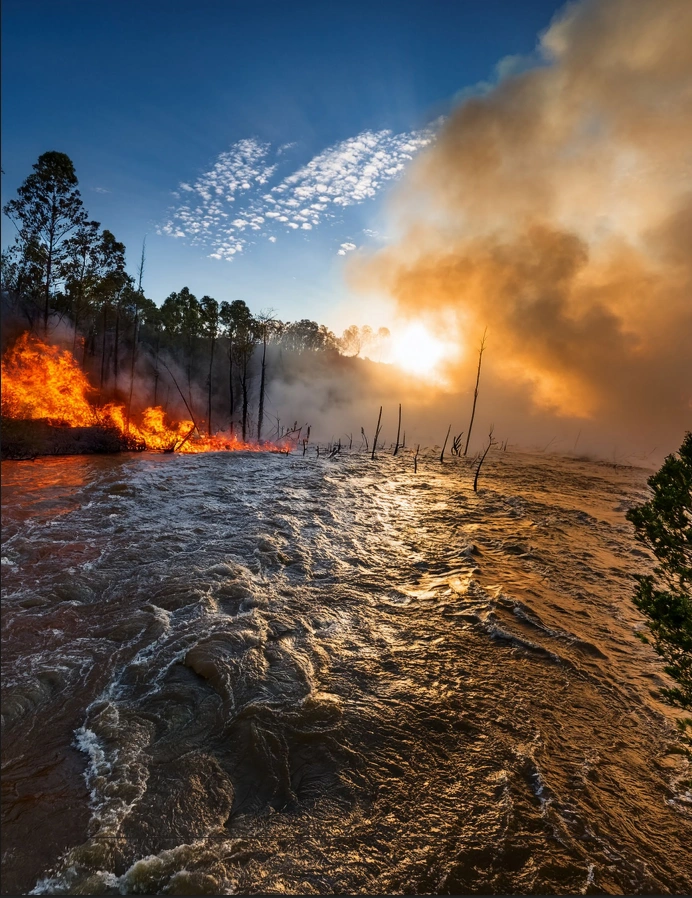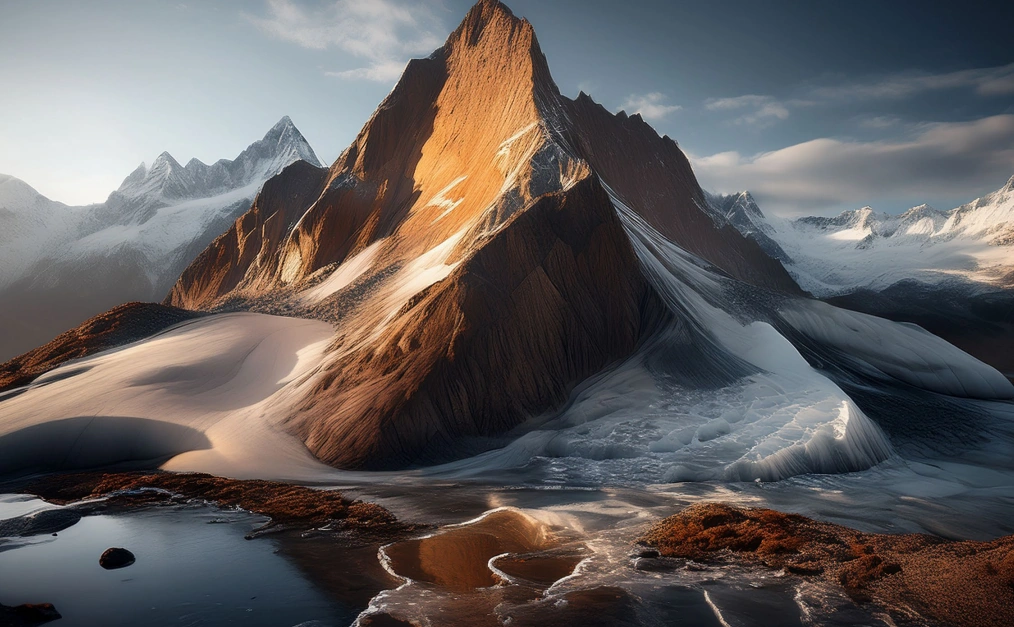The Unraveling Six Climate Disasters Strike
Six Climate Disasters Strike
Simultaneously, Heralding a New Age of Global Breakdown
By Alhanouf Mohammed Alrowaili

August 2025 will be remembered not as a month marked by isolated weather events but as a moment when the global climate crisis revealed itself in frightening simultaneity. Across continents, communities faced disasters that should have been once-in-a-century occurrences, yet they unfolded together within a single month. From record-breaking heat in Scandinavia to the rapid retreat of glaciers in the Alps, from infernos that turned the Mediterranean basin into a fire zone to the devastating floods that submerged entire regions of South Asia, the month underscored an undeniable truth: the world is entering a new era where climate extremes no longer wait their turn, they arrive all at once, compounding and amplifying one another.
The cascade of disasters was not just meteorological but deeply political. As Brazil prepares to host COP30 later this year, the stark contrast between worsening conditions on the ground and the sluggish pace of international negotiations has grown impossible to ignore. August 2025, more than any previous month in memory, showed how the climate emergency is not a distant forecast but a lived reality that millions are already enduring.
Northern Europe Scorched by Unprecedented Heat
Nowhere was this shift more jarring than in Scandinavia. Norway, Sweden, and Finland, countries long associated with cool summers and icy winters—were scorched by a heatwave so prolonged and severe that it defied historical precedent. For Finland, the anomaly was especially stark: more than 22 consecutive days with temperatures above 30°C, something climatologists once considered nearly impossible for the region. According to an attribution study conducted by the World Weather Attribution group, this episode was made at least ten times more likely because of human-induced climate change.
The consequences were immediate and multifaceted. Boreal forests, which serve as one of the planet’s great carbon sinks, began to dry and crack, leaving them vulnerable to wildfires and pest infestations. Vast stretches of lakes bloomed with algae, choking aquatic ecosystems and threatening drinking water supplies. Infrastructure, from energy grids to public health systems, buckled under the sustained heat. What once might have been viewed as an anomaly is increasingly looking like the “new normal” for northern latitudes, one where cool summers are fading into memory, and the Arctic fringe begins to resemble more temperate zones.
Arctic Ice Loss: Svalbard’s Alarming Summer
Further north, the signs of change were written in ice. The Svalbard archipelago, perched high in the Arctic Ocean, experienced an extraordinary melt season that scientists had previously thought would unfold over decades. Satellite data confirmed that one percent of the region’s total ice mass disappeared in a single summer, marking the most dramatic annual loss on record. To the uninitiated, one percent might sound negligible, but glaciologists stress that such rapid melting is unprecedented at this scale.

The consequences extend well beyond the Arctic. The loss accelerates global sea-level rise, threatens local biodiversity such as walrus populations and polar bears, and disrupts atmospheric circulation patterns that regulate weather systems in Europe and Asia. “We are witnessing changes that destabilize not only the Arctic ecosystem but global climate stability itself,” one Norwegian climate scientist warned in a press briefing. Svalbard’s rapid loss serves as a harrowing reminder that the polar regions—once considered stable for centuries are unravelling at a pace that outstrips even the most pessimistic projections.
The Vanishing Ventina Glacier
Far to the south, in the Italian Alps, another story of vanishing ice was unfolding. The Ventina Glacier, located in the Lombardy region, has retreated 1.7 kilometers over the past century, but nearly half of that retreat has taken place since 2021. Entire monitoring systems, ice stakes drilled deep into the glacier, have collapsed or disappeared under rubble, forcing researchers to rely on drones and remote sensing technology just to track the glacier’s shrinking footprint.
For the communities downstream, the disappearance of Ventina is more than symbolic. Alpine glaciers provide essential water supplies for agriculture, hydroelectricity, and drinking water. As the ice vanishes, so too does the seasonal water reservoir that millions rely on, threatening crop yields across northern Italy and destabilizing ecosystems that depend on consistent meltwater. Glaciologists warn that the accelerating retreat is not an isolated occurrence but part of a broader crisis across Europe’s mountain ranges.
Fire Without End in Iberia
While ice vanished in the north, flames consumed the south. Spain and Portugal faced a wildfire season so persistent that it carried well into September, long after peak summer heat had subsided. In Spain alone, forests and farmlands equivalent to twice the size of London were reduced to ash. Drought conditions that had built up over years, combined with record-breaking summer heat and dry winds, created landscapes primed for ignition.
The fires forced mass evacuations, destroyed crops, and polluted air for millions, stretching firefighting resources thin. Governments mobilized thousands of troops and declared disaster zones, but the persistence of fires even in cooler conditions illustrates how climate change has transformed wildfire dynamics. The Iberian Peninsula’s fire season no longer ends with summer; it lingers, gnawing at landscapes into autumn, and reminding residents that the rhythms of old seasons are breaking down.

South Asia Submerged
Monsoon Fury
Yet perhaps the most devastating human tragedy of August 2025 unfolded in South Asia, where the monsoon rains arrived with terrifying force. India, Pakistan, Bangladesh, and Nepal faced some of the heaviest floods in living memory, a disaster that the United Nations declared a Level-3 humanitarian emergency, the highest possible classification.
In India, rivers burst their banks across the states of Bihar, Assam, and Uttar Pradesh, killing more than 1,200 people and displacing over 12 million. Entire villages were washed away, schools and hospitals were submerged, and crops that sustained tens of millions were lost beneath muddy waters. Pakistan, still reeling from the catastrophic 2022 floods, saw its Sindh and Punjab provinces inundated once again. More than five million people were directly affected, with families crowding onto highways and embankments to escape the rising waters.
Bangladesh, a country uniquely vulnerable to monsoon flooding because of its low-lying geography, found one-third of its landmass under water. The capital, Dhaka, struggled with urban flooding so intense that residents navigated streets by boat. Hospitals overflowed with patients suffering from waterborne diseases. In Nepal, torrential rains unleashed deadly landslides in the Himalayan foothills, cutting off entire communities and leaving rescue teams scrambling.
The science behind these floods is clear. Warmer air holds more moisture, leading to more intense rainfall events. Meanwhile, Himalayan glaciers, themselves destabilized by rising temperatures, contributed additional meltwater to already swollen rivers. Coupled with rampant deforestation and rapid urbanization that stripped the land of its natural ability to absorb water, the floods became a perfect storm of human vulnerability and climatic stress.
For millions across South Asia, this was not simply a natural disaster but a stark illustration of inequality. Communities that have contributed the least to global greenhouse gas emissions found themselves bearing the heaviest burdens of climate disruption. The floods also reinforced fears about climate migration, as families displaced in 2025 may never be able to return to their homes, pushing them into overcrowded urban centers or across national borders.
Political Urgency in Brazil
Against this backdrop of escalating disaster, Brazil, host of COP30 in Belém, issued an urgent appeal to the international community. The government warned that, as of August, only 28 countries had submitted updated national climate plans, far fewer than required to keep the Paris Agreement’s goals within reach. The message was blunt: without immediate, ambitious action to curb emissions, the world is on track to exceed 2°C of warming within decades, a trajectory that scientists say would trigger catastrophic and irreversible impacts.
The symbolism was powerful. As Brazil grappled with its own environmental dilemmas, including rising deforestation in the Amazon, it positioned itself as a convener of last resort, urging nations to step beyond rhetoric and deliver measurable action. Whether global leaders will heed the call remains to be seen, but the disasters of August 2025 have stripped away any pretense that the world has more time to waste.
A Global Pattern of Extremes
Though Scandinavia, Svalbard, the Alps, Iberia, and South Asia captured headlines, they were far from the only regions in crisis. Japan recorded its highest-ever temperature of 41.2°C, while South Korea endured its worst wildfire season on record. Canada watched more than 7.25 million hectares of forest burn, while Russia’s Far East lost more than 600,000 hectares to flames. Even Moscow, better known for icy winters than deluges, saw a record 3.6 inches of rainfall in a single night after enduring an oppressive heatwave, collapsing transport networks and flooding metro stations.
Taken together, these disasters reveal a pattern: climate extremes are not isolated events but part of a global mosaic of disruption. Each crisis amplifies the next, creating feedback loops that stretch human resilience to the breaking point.
Conclusion: A Closing Window
August 2025 stands as a grim inflection point. It showed, more clearly than ever before, that the climate crisis is no longer confined to models or projections. It is here, it is global, and it is accelerating. The floods in South Asia, the fires in Iberia, the retreat of glaciers in the Alps, and the searing heat in Scandinavia are not disparate stories but interconnected chapters in a single narrative of planetary change.
The question now is not whether climate change is real, but whether humanity will act in time. With COP30 looming, the stakes have never been higher. The world must decide if it will meet this moment with bold, collective action or allow the window for meaningful change to close. For millions already living through displacement, hunger, and loss, that window is not abstract; it is the difference between survival and collapse.


